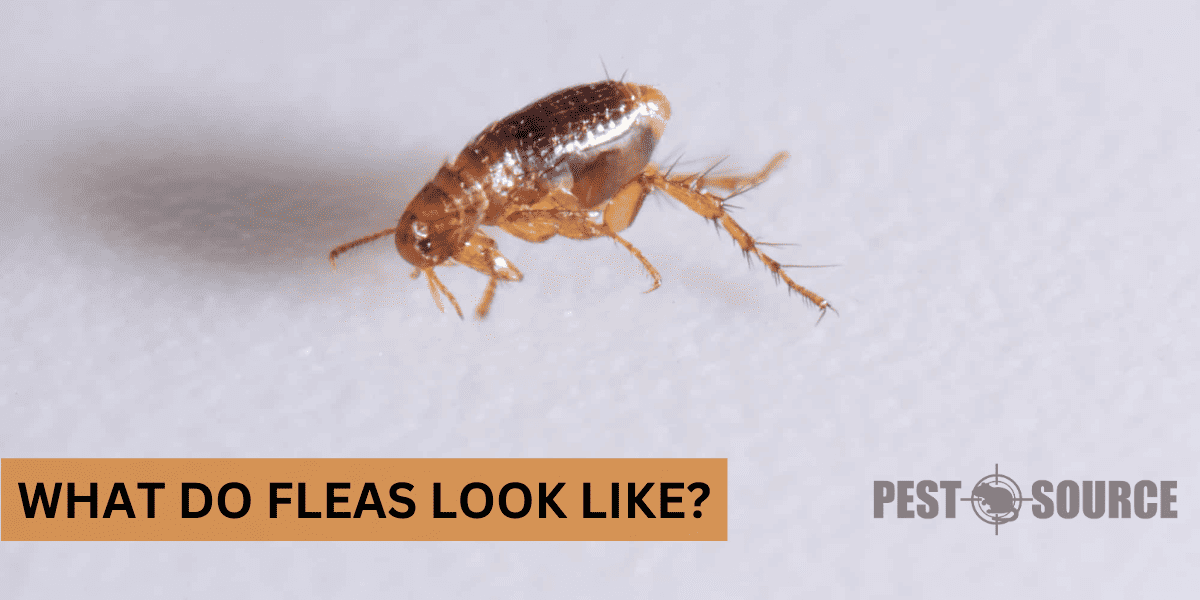Fleas are tiny, pesky bugs that can cause a lot of damage. They’re difficult to see, but it’s important to be able to identify them so you can take the necessary steps to get rid of them. In this post, we’ll take a look at what fleas look like so you can identify an infestation. Stay tuned!
Physical Characteristics
- Size: Adult fleas are typically about 2.5 mm long.
- Color: They are usually dark brown in color.
- Body: Fleas have a thin, flat body shape, which is covered in tiny hairs. This body shape aids in moving through the fur or feathers of their hosts.
- Exoskeleton: They possess a hard exoskeleton, which helps in protecting them against the scratches and bites of their hosts.
- Mouthparts: Fleas are equipped with long mouthparts adapted for piercing skin and sucking blood.
- Legs: They have six long legs, with the hind pair being well adapted for jumping. Fleas are capable of jumping distances over 100 times their body length.
- Antennae: Fleas have short antennae, which are often difficult to see.
- Wings: Unlike many insects, fleas do not have wings and are unable to fly.
- Sensory Organs: They have complex sensory organs that are adept at detecting heat, vibrations, and exhaled carbon dioxide, all of which help them locate a host.
- Reproductive Organs: Female fleas have a reproductive system designed for laying large quantities of eggs, while males have reproductive organs for fertilizing eggs.
- Metamorphosis: Fleas undergo complete metamorphosis, with life stages including egg, larva, pupa, and adult. The larval stage looks quite different from the adult, being smaller and worm-like.
What is a flea?
Fleas are small, wingless, dark brown or black insects that are approximately 1/12 inch long. They have six legs and are flat from side to side. Fleas are capable of jumping up to 13 inches, which is about 200 times their body length. The most commonly found flea pest in homes is the cat flea, although dog fleas can also be a problem. Fleas parasitize mammals and birds, and they can be a nuisance to both pets and humans. Fleas feed on the blood of their host, and they can transmit diseases.
What do fleas look like under a microscope?
When viewed under a microscope, fleas appear to be small, oval-shaped insects with a tiny head and six legs that dangle underneath the body. The back legs are noticeably longer than the others, and all of the legs are equipped with sharp claws that help the flea to cling to its host. The body is covered in a hard exoskeleton, and the sides of the abdomen are lined with small bristles. Fleas are dark brown in color, and their bodies are often covered in dried blood from previous meals.
Different stages in life cycle

Fleas will look different in each stage of their lifecycle. Here’s a rundown of what to look for.
Eggs
Flea eggs are small, smooth, oval, and pearlescent. They are visible to the naked eye and hatch one to six days after being laid, depending on temperature and humidity. Eggs are generally concentrated in areas that are most frequently visited by the pet such as carpets, bedding, dog houses etc., but can be deposited anywhere the pet has been. When they hatch, flea eggs become tiny larvae that feed on organic debris in the environment.
Larvae
Flea larvae are small, white worms that are about one-tenth of an inch long. They have black heads and no legs. Flea larvae generally live in carpeting, upholstered furniture, and bedding. They feed on flea excrement, which is dried blood produced from feeding on the host. This is called “flea dirt.” Flea dirt is often mistaken for flea larvae or eggs. Flea larvae generally last six to thirty-six days, but may last longer. Once they mature, they spin a cocoon and transform into pupae.
Pupae
While adult fleas are dark brown or black in color, flea pupae are white or off-white. They have the same general body shape as adult fleas, but their antennae are shorter and they lack wings. Pupae are often found within cocoons, where they remain until they emerge as adults. Although pupae make up a crucial stage in the flea life cycle, they are rarely seen by people since they typically spend their time hidden away in cocoons.
Adult
Adult fleas are 1.5 to 3.2 mm long and have a dark brown body with a glossy sheen. Fleas have six legs and three body segments. Their bodies are flattened side-to-side, and they have two black, simple eyes. The legs of fleas are specialized for jumping; they can jump up to 200 times their body length.
Where are fleas found?
Anyone who has ever had a flea infestation knows just how difficult these pests can be to get rid of. Fleas reproduce quickly and are adept at hiding from their hosts, making them a stubborn problem for both pet owners and homeowners. A better understanding of flea biology can help in the battle against these pests.
Fleas lay their eggs on animals or in areas where animals frequent, such as bedding, furniture, carpeting, and appliances. The eggs hatch into larvae within a few days to two weeks, depending on the temperature and humidity. Flea larvae prefer dark, narrow spaces that offer protection. They are often found on floors and in-between carpet fibers. Once they have reached full size, the larvae spin cocoons and transform into adult fleas. Adult fleas hide only on live hosts such as cats, dogs, rodents, and other furry mammals. Outside, fleas can be found in high grasses, sand, sheds, and debris–places where they can find shade and humidity. The most densely infested areas on pets’ bodies are around the neck, ears, and underbelly.
How do you know if you have fleas in the house?
If you think you might have fleas in your home, there are a few things to look for. First, check your pets. If they are scratching themselves more than usual, it could be a sign that they have fleas. You should also examine their bedding for a salt and pepper mixture – this is caused by flea eggs and digested blood from adult fleas. Finally, take a close look at your pet’s skin for any signs of adult fleas, scabs from bites, or “flea dirt.” If you find any of these things, it’s likely that you have a flea infestation. Fleas can travel from pets to humans, so be on the lookout for specks on your sheets or floor which may be evidence of eggs and dead fleas. If you think you have fleas in your home, it’s important to take action to get rid of them as soon as possible.
How do you get rid of fleas?
To get rid of fleas, understanding what fleas look like is crucial. This knowledge can assist in early detection and prevention, which is essential as these parasites can cause discomfort and health issues to pets and humans. Effective flea control strategies often include a combination of regular cleaning of pet bedding, vacuuming, use of flea prevention products on pets, and professional pest control services when necessary.



